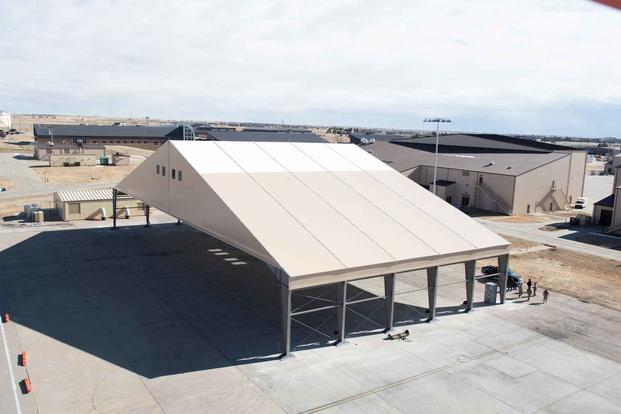The U.S. Air Force has begun constructing prototype shelters in anticipation of someday housing its next-generation bomber, B-21 Raider.
The service has erected a temporary prototype "Environmental Protection Shelter" at Ellsworth Air Force Base, South Dakota, one of a few mock-up models that Air Force Global Strike Command and the B-21 Program Office are testing to find the most effective and affordable option for the Long Range Strike Bomber, according to release.
"Environmental Protection Shelters help extend the life of the aircraft and reduce required maintenance by limiting UV exposure, limiting snow accumulation and melt, and limiting icing/de-icing operations experienced by the aircraft over time," Col. Derek Oakley, the command's B-21 Integration and System Management Office director, said in the release
Read Next: As the Navy Moved to Fire Capt. Crozier, Other Leaders Rallied Around Him
"These shelters also help us generate sorties more quickly by eliminating the need to always have to move aircraft in and out of hangars," he said in the March 3 announcement.
Air Force Magazine reported last week that the shelter is 200 feet wide and 100 feet deep, which is also big enough for the B-2 Spirit bomber. While the B-2's wingspan runs 172 feet, it's unknown how long or wide the B-21 aircraft may be.
The Air Force has said deliveries of the Raider, manufactured by Northrop Grumman, will begin in the mid-2020s. But the service has been careful not to broadcast details in order to protect its technology.
The Air Force is weighing just how many prototype shelters to place at each of the chosen B-21 bases. In 2019, the service named Ellsworth to become the first operational B-21 base; it will also host the bomber's first formal training unit. Dyess Air Force Base, Texas, is the service's preferred alternative. Dyess and Whiteman Air Force Base, Missouri, are expected to receive B-21 Raiders "as they become available," the service said at the time.
Following an environmental study, the Air Force will make its formal decision this summer on the final bases to host the B-21.
The service chose Ellsworth as its first EPS hangar location because its "weather conditions offer the opportunity to collect the most diverse amount of data," according to the release.
"We will collect a few years of data on these shelters and then incorporate that data into the final Environmental Protection Shelter design," Oakley said.
Any needed bomber maintenance will occur in indoor maintenance hangars, which is routine, he added.
In January, service officials held a virtual B-21 industry day to discuss various construction projects. Other facilities the B-21 will need, such as a low observable maintenance hangar to repair stealth coating and a general maintenance hangar, are in the planning stages, officials said.
The Air Force has said it plans to procure at least 100 Raiders, rounding out its bomber inventory to 175, including its B-52 Stratofortress fleet.
However, Gen. Tim Ray, head of Air Force Global Strike Command, has often proposed a bomber force of more than 200 aircraft.
"We've said publicly that we think we need 220 bombers overall -- 75 B-52s and the rest B-21s, long term," Ray told Air Force Magazine last year.
The Raider passed its critical design review in December 2018, a pivotal milestone for the program.
-- Oriana Pawlyk can be reached at oriana.pawlyk@military.com. Follow her on Twitter at @Oriana0214.
Related: The Air Force Plans to Retrain Weapons System Officers to Be B-21 Bomber Pilots














